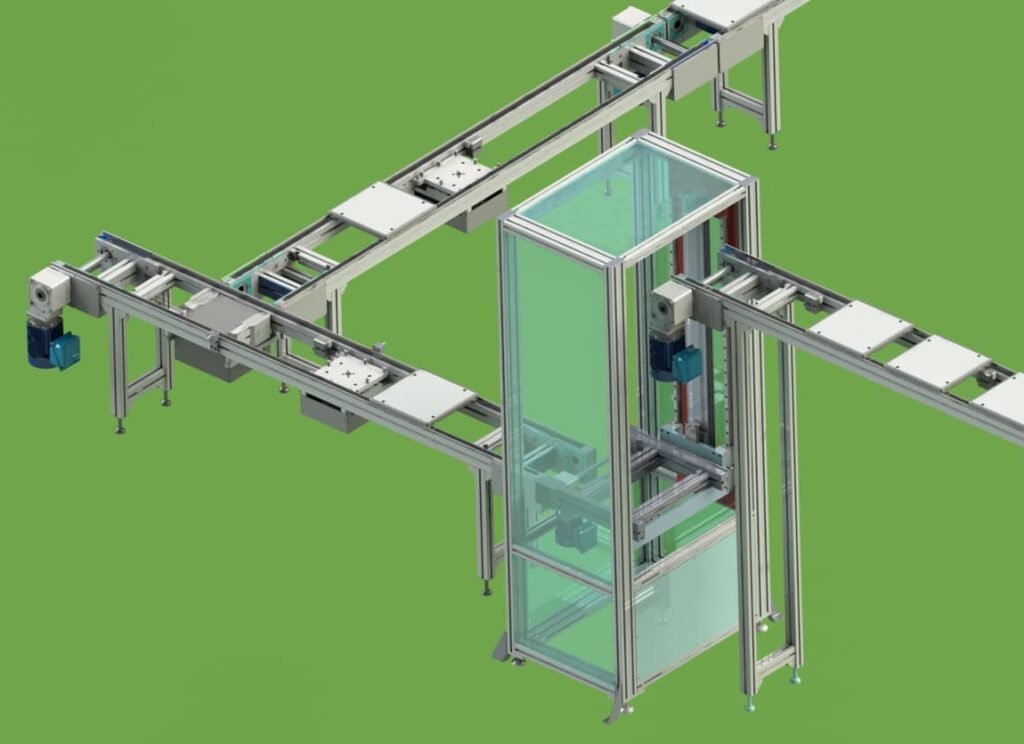目录
- 简介:什么是传送带?
- 输送带的主要部件
- 2.1 传送带
- 2.2 滑轮
- 2.3 驱动电机
- 2.4 惰轮
- 2.5 传送带材料
- 2.6 框架
- 2.7 拉伸器
- 输送系统的类型
- 输送系统在工业中的作用
- 输送系统如何提高效率和生产力
- Vitrans 自动化设备有限公司- 领先的输送机制造商
- 为您的应用选择合适的输送机系统
- 常见问题
- 结论
简介:什么是传送带?
传送带 是各行各业的重要设备,能将材料从一个点高效地运输到另一个点。它们广泛应用于 工厂、仓库、机场和其他工业环境.输送带系统通常由几个部分组成,它们共同执行物料输送任务。
无论您是在生产线上搬运货物,还是运输材料进行分拣,都需要了解输送机的关键部件 输送带系统 是确保其最佳功能和使用寿命的关键。在本文中,我们将分解传送带系统的基本组成部分,并讨论每个部分如何对其整体性能做出贡献。

输送带的主要部件
输送带系统由几个关键部件组成,它们相互配合以高效地输送物料。让我们来看看构成传送带系统的各个主要部件。
2.1 传送带
"(《世界人权宣言》) 输送带 是系统中最重要的部分。它是将材料从一个点运送到另一个点的运动表面。输送带可根据应用情况由不同材料制成,包括橡胶、织物或金属。
皮带的设计可承受磨损,并可承载不同重量和尺寸的材料。
2.2 滑轮
滑轮 是输送带系统运行的关键。它们用于改变输送带的方向并帮助保持张力。滑轮通常有两种类型:
- 驱动滑轮:这是主滚筒,位于传送带的头部。它由电机提供动力,驱动传送带运动。
- 尾滑轮:尾部滚筒位于输送机的另一端,有助于保持输送带绷紧和对齐。
滑轮通常由钢或其他耐用材料制成,以承受移动材料时持续产生的压力。
2.3 驱动电机
"(《世界人权宣言》) 驱动电机 负责为输送带系统提供动力。它将电能转化为机械能,使输送带移动。根据输送机系统的大小和容量,驱动电机的功率和速度会有所不同。
- 电机类型:
- 电机:常用于现代输送系统,以提高效率和控制。
- 液压马达:用于需要高扭矩的重型应用。
- 气动马达:适用于需要防爆设备或电气元件可能构成危险的环境。
驱动电机与滑轮配合,将运动传递到传送带上。
2.4 惰轮
惰轮 是在输送带穿过系统时支撑输送带的滚筒。它们有助于引导输送带,确保输送带保持对齐,不会从轨道上滑落。托辊主要有两种类型:
- 搬运惰轮:这些部件位于传送带下方,支撑着输送物料的重量。
- 返回惰轮:这些惰轮位于皮带的回程侧,有助于引导皮带回到起点。
惰轮通常由钢或塑料制成,以提供必要的支撑和耐用性。
2.5 传送带材料
"(《世界人权宣言》) 传送带材料 是指用于制造输送带表面的物质。材料的选择取决于运输物品的重量、行业类型和环境条件等因素。
- 常用材料:
- 织物:轻便灵活,常用于食品加工等行业。
- 橡胶:具有耐久性和抗磨损性,常用于散装物料搬运。
- 钢:强度高、耐高温,是重型或高温应用的理想选择。
- 聚氨酯:用于对耐化学和耐磨性要求较高的行业。
根据应用的具体需求,每种材料都有自己的优势。
2.6 框架
"(《世界人权宣言》) 画框 输送机系统的输送带支撑着输送带的结构和部件。它提供了必要的框架,使所有部件稳固就位,并确保输送机平稳运行。
- 材料选择:
- 钢框架:由于其强度和耐用性,在重型和工业应用中很常见。
- 铝框:重量轻、耐腐蚀,常用于食品处理和制药行业。
框架的设计可确保整个系统稳定,传送带直线运行,不会下垂或错位。
2.7 拉伸器
拉伸器 用于调节和保持输送带的张力。适当的张力对输送系统的高效运行至关重要。张力过大会导致输送带磨损,而张力过小则会导致输送带打滑或错位。
- 拉伸器类型:
- 手动拉伸器:需要手动调节才能达到所需的张力。
- 自动拉伸器:可自动调节张力,确保最佳性能。
张紧器有助于保持输送带的平衡和使用寿命,确保其长期平稳运行。
输送系统的类型
输送机系统有各种设计和配置,可满足不同行业的需求。以下是一些常见的类型:
- 带式输送机:最常见的输送系统,用于包装和采矿等行业。
- 辊筒输送机:适用于运输重型货物,尤其是在仓库和配送中心。
- 气动输送机:利用气压移动材料,通常用于食品和制药行业。
- 板式输送机:以板条代替皮带,是重型应用的理想选择。
根据输送的物料和应用要求,每种类型的输送系统都有自己的优势。
输送系统在工业中的作用
输送机系统通过改善物料处理和运输,在许多行业发挥着重要作用。输送机系统的一些主要优点包括
- 提高效率:输送机系统可以更快、更稳定地输送物料,减少对人工的需求。
- 加强安全:通过自动化物料搬运,输送机可降低工人因举起和移动重物而受伤的风险。
- 成本效益:自动化输送机可通过提高吞吐量和减少停机时间来降低运营成本。
食品加工、汽车制造、制药和物流等行业在很大程度上依赖输送系统来简化操作和提高生产率。
输送系统如何提高效率和生产力
输送机系统可以实现货物运输自动化,减少人工劳动,并确保稳定的吞吐量,从而显著提高运营效率。以下是输送系统提高生产率的几种方法:
- 连续运行:与人工搬运不同的是,输送机可以连续运行,从而使物料不间断地稳定流动。
- 降低劳动力成本:自动化减少了对人工的需求,从而节省了劳动力成本。
- 改进工作流程:输送系统有助于组织物料流,防止出现瓶颈和延误。
在制造和配送等快节奏行业中,输送机有助于保持稳定的生产率,满足苛刻的最后期限要求。
Vitrans 自动化设备有限公司- 领先的输送机制造商
Vitrans 自动化设备有限公司 是一家位于中国东莞的知名输送机制造商。该公司专门提供高质量的模块化托盘输送机系统和各种输送机产品,如齿形带、平带、平顶链、积放链和滚筒。
凭借在生产线规划和装配自动化方面的多年经验,Vitrans 已成为全球企业值得信赖的合作伙伴。他们致力于研究、开发和生产,确保每个输送机系统都符合效率、可靠性和定制化的最高标准。
为您的应用选择合适的输送机系统
选择合适的输送系统取决于多个因素,包括
- 材料类型:考虑需要运输的材料类型(如散装、重型、易碎)。
- 环境:确定输送机是否将在高温或潮湿等恶劣条件下运行。
- 能力要求:选择能够处理所需运输的物料量的输送机。
- 速度与效率:考虑输送机需要以多快的速度输送物料才能实现生产目标。
Vitrans 提供各种输送机系统,可根据您的具体需求进行定制,无论您是输送轻型包裹还是重型物料。
常见问题
1. 工业中最常用的输送机类型是什么?
"(《世界人权宣言》)
工业中最常用的输送机是 皮带运输机它用途广泛、效率高、成本效益高。
2. 如何维护输送带系统?
为维护输送带系统,应确保定期检查、检查输送带张力并更换磨损的部件,如滑轮和托辊。
3. 输送系统可以定制吗?
是的,输送机系统可以根据您的具体需求进行定制,如材料类型、容量和环境条件。
结论
输送机系统是现代工业中不可或缺的工具,可提高物料处理的效率、可靠性和安全性。通过了解关键部件及其功能,可以确保您的输送机系统以最佳性能运行。通过正确选择输送机部件,企业可以优化生产率、降低运营成本并简化工作流程。












